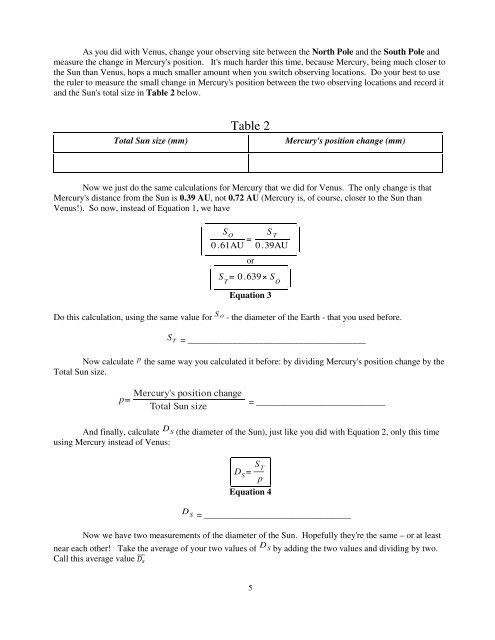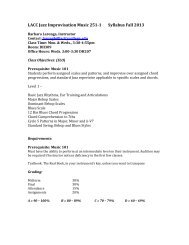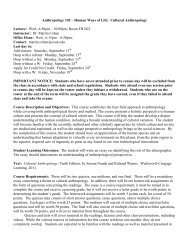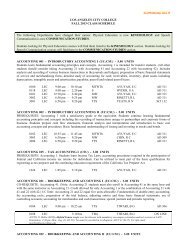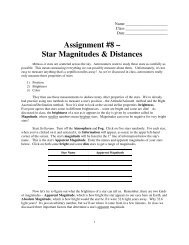Assignment #7 – Transits of Venus & Mercury - Faculty Web Pages
Assignment #7 – Transits of Venus & Mercury - Faculty Web Pages
Assignment #7 – Transits of Venus & Mercury - Faculty Web Pages
You also want an ePaper? Increase the reach of your titles
YUMPU automatically turns print PDFs into web optimized ePapers that Google loves.
As you did with <strong>Venus</strong>, change your observing site between the North Pole and the South Pole and<br />
measure the change in <strong>Mercury</strong>'s position. It's much harder this time, because <strong>Mercury</strong>, being much closer to<br />
the Sun than <strong>Venus</strong>, hops a much smaller amount when you switch observing locations. Do your best to use<br />
the ruler to measure the small change in <strong>Mercury</strong>'s position between the two observing locations and record it<br />
and the Sun's total size in Table 2 below.<br />
Table 2<br />
Total Sun size (mm) <strong>Mercury</strong>'s position change (mm)<br />
Now we just do the same calculations for <strong>Mercury</strong> that we did for <strong>Venus</strong>. The only change is that<br />
<strong>Mercury</strong>'s distance from the Sun is 0.39 AU, not 0.72 AU (<strong>Mercury</strong> is, <strong>of</strong> course, closer to the Sun than<br />
<strong>Venus</strong>!). So now, instead <strong>of</strong> Equation 1, we have<br />
S O<br />
0.61AU =<br />
or<br />
5<br />
S T<br />
0.39AU<br />
S T = 0 .639× S O<br />
Equation 3<br />
Do this calculation, using the same value for S O - the diameter <strong>of</strong> the Earth - that you used before.<br />
S T = ________________________________________<br />
Now calculate p the same way you calculated it before: by dividing <strong>Mercury</strong>'s position change by the<br />
Total Sun size.<br />
p=<br />
<strong>Mercury</strong>'s position change<br />
Total Sun size<br />
= _____________________________<br />
And finally, calculate D S (the diameter <strong>of</strong> the Sun), just like you did with Equation 2, only this time<br />
using <strong>Mercury</strong> instead <strong>of</strong> <strong>Venus</strong>:<br />
D S = S T<br />
p<br />
Equation 4<br />
D S = _________________________________<br />
Now we have two measurements <strong>of</strong> the diameter <strong>of</strong> the Sun. Hopefully they're the same <strong>–</strong> or at least<br />
near each other! Take the average <strong>of</strong> your two values <strong>of</strong> DS by adding the two values and dividing by two.<br />
Call this average value


